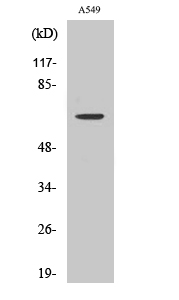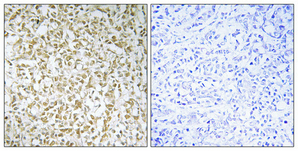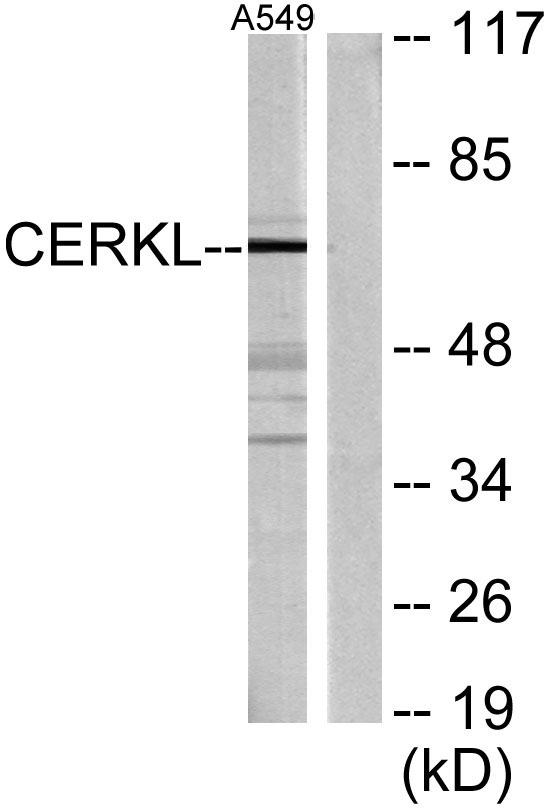CERKL Polyclonal Antibody
- Catalog No.:YT0873
- Applications:WB;IHC;IF;ELISA
- Reactivity:Human
- Target:
- CERKL
- Gene Name:
- CERKL
- Protein Name:
- Ceramide kinase-like protein
- Human Gene Id:
- 375298
- Human Swiss Prot No:
- Q49MI3
- Immunogen:
- The antiserum was produced against synthesized peptide derived from human CERKL. AA range:341-390
- Specificity:
- CERKL Polyclonal Antibody detects endogenous levels of CERKL protein.
- Formulation:
- Liquid in PBS containing 50% glycerol, 0.5% BSA and 0.02% sodium azide.
- Source:
- Polyclonal, Rabbit,IgG
- Dilution:
- WB 1:500 - 1:2000. IHC 1:100 - 1:300. ELISA: 1:20000.. IF 1:50-200
- Purification:
- The antibody was affinity-purified from rabbit antiserum by affinity-chromatography using epitope-specific immunogen.
- Concentration:
- 1 mg/ml
- Storage Stability:
- -15°C to -25°C/1 year(Do not lower than -25°C)
- Other Name:
- CERKL;Ceramide kinase-like protein
- Observed Band(KD):
- 63kD
- Background:
- This gene was initially identified as a locus (RP26) associated with an autosomal recessive form of retinitis pigmentosa (arRP) disease. This gene encodes a protein with ceramide kinase-like domains, however, the protein does not phosphorylate ceramide and its target substrate is currently unknown. This protein may be a negative regulator of apoptosis in photoreceptor cells. Mutations in this gene cause a form of retinitis pigmentosa characterized by autosomal recessive cone and rod dystrophy (arCRD). Alternative splicing of this gene results in multiple transcript variants encoding different isoforms and non-coding transcripts.[provided by RefSeq, May 2010],
- Function:
- developmental stage:Expressed in fetal lung, kidney and brain.,disease:Defects in CERKL are the cause of retinitis pigmentosa type 26 (RP26) [MIM:608380]. RP leads to degeneration of retinal photoreceptor cells. Patients typically have night vision blindness and loss of midperipheral visual field. As their condition progresses, they lose their far peripheral visual field and eventually central vision as well. RP26 inheritance is autosomal recessive.,function:Has no detectable ceramide-kinase activity.,PTM:Phosphorylated on serine residues.,sequence caution:Wrong choice of CDS.,similarity:Contains 1 DAGKc domain.,subcellular location:Enriched in nucleoli. May shuttle between nucleus and cytoplasm. Isoform 5 is not enriched in the nucleoli.,tissue specificity:Moderately expressed in retina, kidney, lung, testis, trachea, and pancreas. Weakly expressed in brain, placenta and liver.,
- Subcellular Location:
- Cytoplasm. Nucleus, nucleolus. Enriched in nucleoli. May shuttle between nucleus and cytoplasm. Isoform 5 is not enriched in the nucleoli.; [Isoform 2]: Cytoplasm. Nucleus, nucleolus. Golgi apparatus, trans-Golgi network. Endoplasmic reticulum.
- Expression:
- Isoform 1 and isoform 2 are expressed in adult retina, liver and pancreas as well as in fetal brain, lung and kidney. Isoform 3 is expressed in adult retina as well as in fetal lung and liver. Isoform 4 is expressed in adult retina, lung and kidney as well as in fetal lung and liver. Moderately expressed in retina, kidney, lung, testis, trachea, and pancreas. Weakly expressed in brain, placenta and liver.
- June 19-2018
- WESTERN IMMUNOBLOTTING PROTOCOL
- June 19-2018
- IMMUNOHISTOCHEMISTRY-PARAFFIN PROTOCOL
- June 19-2018
- IMMUNOFLUORESCENCE PROTOCOL
- September 08-2020
- FLOW-CYTOMEYRT-PROTOCOL
- May 20-2022
- Cell-Based ELISA│解您多样本WB检测之困扰
- July 13-2018
- CELL-BASED-ELISA-PROTOCOL-FOR-ACETYL-PROTEIN
- July 13-2018
- CELL-BASED-ELISA-PROTOCOL-FOR-PHOSPHO-PROTEIN
- July 13-2018
- Antibody-FAQs
- Products Images

- Western Blot analysis of various cells using CERKL Polyclonal Antibody

- Immunohistochemical analysis of paraffin-embedded Human breast cancer. Antibody was diluted at 1:100(4° overnight). High-pressure and temperature Tris-EDTA,pH8.0 was used for antigen retrieval. Negetive contrl (right) obtaned from antibody was pre-absorbed by immunogen peptide.

- Western blot analysis of lysates from A549 cells, using CERKL Antibody. The lane on the right is blocked with the synthesized peptide.



